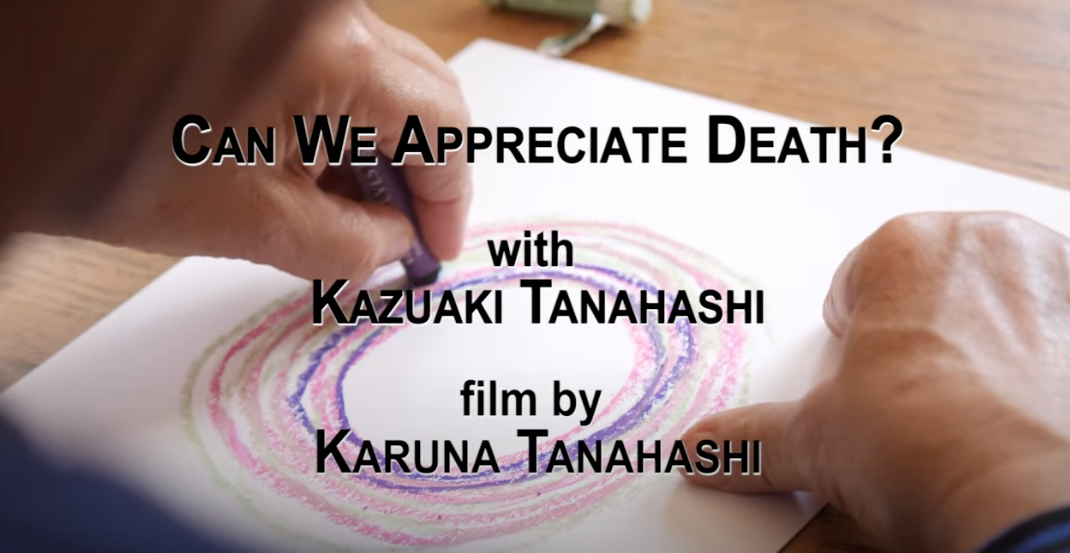Kazuaki Tanahashi
Welcome to BRUSHMIND. Kaz Tanahashi, who was trained by O’Sensei, Morihei Ueshiba, in the only class of Aikido in Japan soon after World War II, helped translate one of O’Sensei’s memoirs. An expert on Zen and East Asian calligraphy, Kaz is the artist of the works presented in this web site. All lines start with a single point but a fully focused brush movement follows it to create form and expression.
Upcoming Workshops
Just Released!
A new film by Karuna Tanahashi with Kaz Tanahashi titled "Can We Appreciate Death"
Click on the title below to read an excerpt from Kaz’s new book “Reverse Aging”
-
“De-age” is not a scientific term (yet). But the term “reverse aging” is used by an outstanding Austrian biologist David Sinclair, PhD, author of the 2019 book Lifespan: Why We Age – and Why We Don’t Have To with Matthew D. LaPlante.
Professor of genetics at the Harvard Medical School, and co-director of the Biology of Aging Research at Harvard, Dr. Sinclair is a leading scientist in the field. He says, “There are things we can do to slow, stop, and even reverse aspects of aging.”
The author discusses in detail on how yeast, mammals, and humans age through the ongoing progress and the future potentials of wide-ranging genetic and small molecule studies worldwide. Then he says, “Aging is not an inevitable part of life but rather a disease process with a broad spectrum of pathological consequences.” Aging in fact is the mother of all diseases. As it is a disease, it is curable and reversable. Then he suggests that this notion is starting to be accepted in the scientific community.
Sinclair suggests that lifestyle change is most basic for prolonging vitality. I will introduce his practical advices later in this book.
Then he talks about “longevity drugs”:
The evidence of the effectiveness of AMPK activators, TOR inhibiters, and sirtrun activators is deep and wide. On top of what we already know about metformin, NAD boosters, rapalongs, and senolytics, every day the odds increase that even more effective molecule or gene therapy will be discovered.
Sinclair says research on longevity drug is still in progress and he doesn’t recommend any supplement, but he reveals of his own daily intake: “I take 1 gram of NMN every morning, along with 1 gram of resveratrol (shaken into my homemade yogurt) and 1 gram of metformin.” He also refers to his colleague scientists of aging: “I’d wager that about a third of them take metformin or an NAD booster. A few of them even take low doses of rapamycin intermittently.”
The author talks about his father, also a scientist, whose health was on decline in his late 70’s. He had passed the type 2 diabetes threshold, was losing his hearing, and his eyes were starting to go bad. He would tire fast. He repeated himself. He was grumpy… Then he started taking NMN daily and six months later, he was feeling less tired, less sore, more mentally aware. The smile returned to his face. He added metformin to NMN each morning. Later in his 80’s David’s father runs around like a teenager. Hiking for six days through wind and snow to reach the peak of the highest mountain in Tasmania… Whitewater rafting in Montana. Ice cave exploring in Austria. What a remarkable anecdote!
In cell biology, telomeres, repeating segment of noncoding DNA, less than one-ten-thousandth of DNAs of our cells, that live at the ends of your chromosomes. Telomeres that serve as protective caps throughout our body become shorter at each cell division as we age, and this underlying mechanism contribute to most diseases of aging.
We humans are a lump of 30-plus trillion cells. These cells vary in their shapes, sizes, weight, functions, and how long they live. Cells are constantly dying, and new ones are being made simultaneously. Chromosomes—dark staining threads in the cell nucleus—carry information for cell heredity. Chromosomes are about half DNA (twisted double helix) and half protein by weight.
In 1983, in her lab at UC Berkeley, an Australian molecular biologist Elizabeth Blackburn, PhD, discovered that telomerase creates new telomeres patterned on its own biochemical sequence by attracting an unknown enzyme, which her lab named telomerase. That means “telomere attrition is a clear and an early contributor to the aging process, and—more exciting—it is possible to slow or even reverse that attrition.” Thus, Dr Blackburn received Nobel Prize.
Further she discovered: “Your telomeres, it turns out, are listening to you. They absorb the instructions you give them. The way you live can, in effect, tell your telomeres to speed up the cellular aging. But it can also do the opposite.”
Test kits to measure your biological age are already available in market. You can search them in the Internet.
A part of FRESH: The art of de-aging and joyful living, in progress. ©2024, Kazuaki Tanahashi
Artworks by Kaz
Please view my newly posted scrolls in Brush Calligraphy and One Stroke Paintings
Delight in One Thousand Characters: The Classic Manual of East Asian Calligraphy Paperback, Shambhala Publications, August 30, 2022
ISBN 9781611808735
A beautifully curated presentation of the Thousand Character Essay, a masterpiece of Chinese calligraphy that has served as the art form’s classic manual for over 1,400 years.
https://www.shambhala.com
30% Discount Code https://www.shambhala.com for Delight in One Thousand Characters DIOTC30
The code is valid until September 30, 2022. It works for pre-orders and also orders after publication date. The code is only for print copies through shambhala.com and is most cost-effective for people in North America. Enter code in shopping cart. Cannot be combined with other offers.
Please go to zenbrush.net to purchase Painting Peace DVD.






